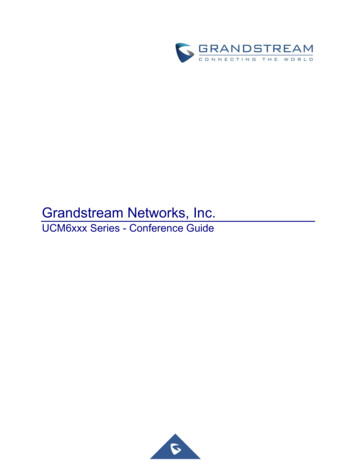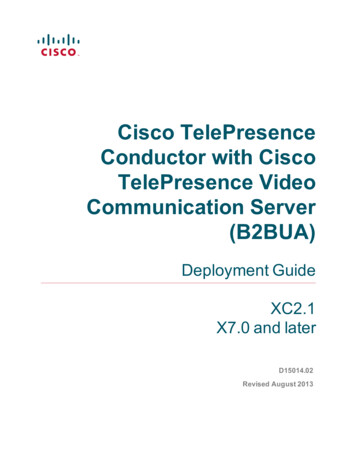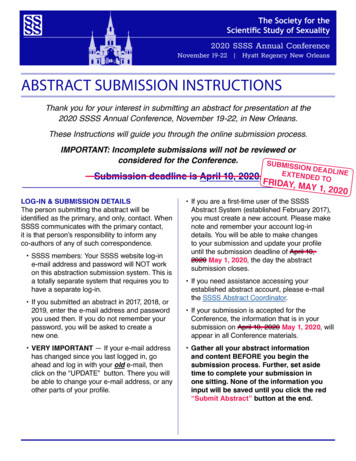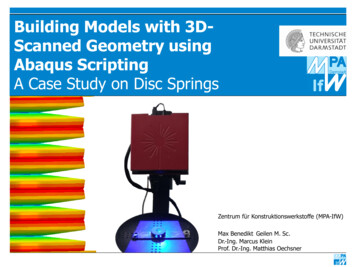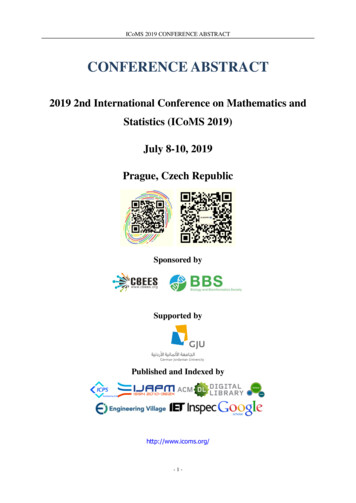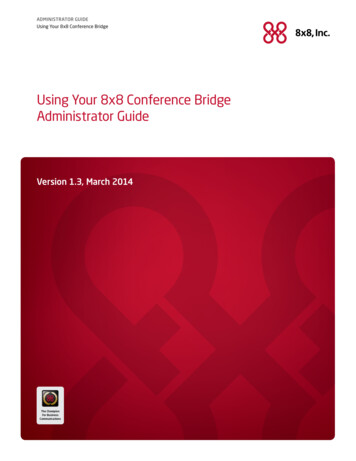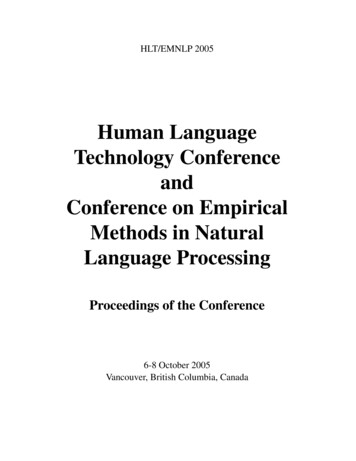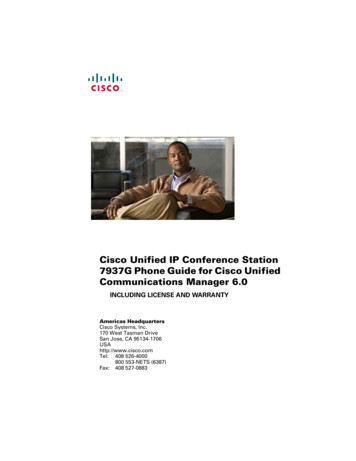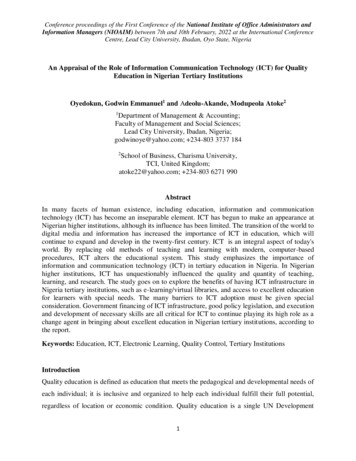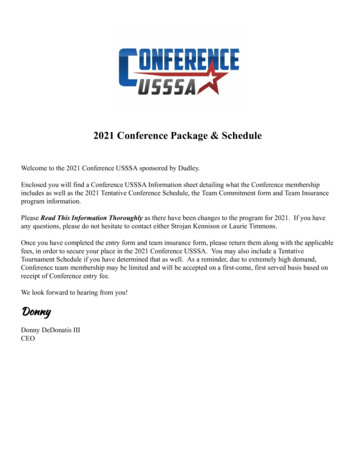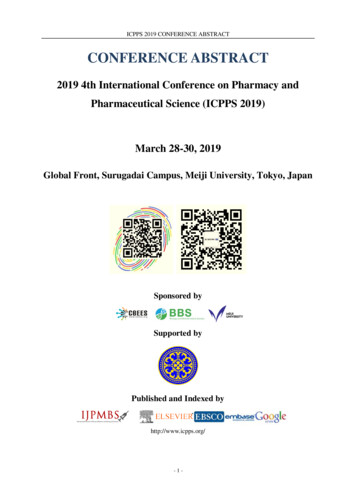
Transcription
ICPPS 2019 CONFERENCE ABSTRACTCONFERENCE ABSTRACT2019 4th International Conference on Pharmacy andPharmaceutical Science (ICPPS 2019)March 28-30, 2019Global Front, Surugadai Campus, Meiji University, Tokyo, JapanSponsored bySupported byPublished and Indexed byhttp://www.icpps.org/-1-
ICPPS 2019 CONFERENCE ABSTRACTTable of ContentsICPPS 2019 Conference Introduction3Presentation Instruction4Hornored Speaker Introduction5Detailed Schedule for Conference13Parallel Sessions Index16Schedule of Sessions18Poster Session 145Poster Session 299Listener Name List108Conference Venue111Academic Visit & Tour113Note115Feedback Information119-2-
ICPPS 2019 CONFERENCE ABSTRACTICPPS 2019 Conference IntroductionWelcome to 2019 4th International Conference on Pharmacy and Pharmaceutical Science (ICPPS 2019)which is sponsored by Hong Kong Chemical, Biological & Environmental Engineering Society (CBEES)and Biology and Bioinformatics (BBS). The aim and objective of the 2019 4th International Conference onPharmacy and Pharmaceutical Science (ICPPS 2019) is to provide a platform for researchers, engineers,academicians as well as industrial professionals from all over the world to present their research results anddevelopment activities in pharmacy and pharmaceutical science. This conference provides opportunities forthe delegates to exchange new ideas and application experiences face to face, to establish business orresearch relations and to find global partners for future collaboration.Papers will be published in one of the following journals:Asian J Pharm Clin Res (AJPCR, Print ISSN- 0974-2441, Online ISSN-2455-3891),indexed by Google Scholar, Elsevier, EBSCO, EMBASE, SCI mago (SJR), CNKI,CAS, CASSI (American Chemical Society), Directory of Open Access Journal (DOAJ),Index Copernicus, ICAAP, Scientific commons, PSOAR, Open-J-Gate, Indian CitationIndex (ICI), Index Medicus for WHO South-East Asia (IMSEAR), OAI, LOCKKS,OCLC (World Digital Collection Gateway), UIUC. Impact- 0.40 (SCImago, SJR 2016).International Journal of Pharma Medicine and Biological Sciences (IJPMBS,ISSN: 2278-5221), indexed by Embase; ProQuest; International Committee of MedicalJournal Editors(ICMJE); Health sciences library(NYU); HINARI Access to Researchin Health Programme; etc.Conference website and email: http://www.icpps.org/; icpps@cbees.net-3-
ICPPS 2019 CONFERENCE ABSTRACTPresentation InstructionInstruction for Oral PresentationDevices Provided by the Conference Organizer:Laptop Computer (MS Windows Operating System with MS PowerPoint and Adobe AcrobatReader)Digital Projectors and ScreenLaser StickMaterials Provided by the Presenters:PowerPoint or PDF Files (Files should be copied to the Conference laptop at the beginning ofeach Session.)Duration of each Presentation (Tentatively):Keynote Speech: about 35 Minutes of Presentation and 5 Minutes of Question and AnswerPlenary Speech: about 35 Minutes of Presentation and 5 Minutes of Question and AnswerInvited Speech: about 15 Minutes of Presentation and 5 Minutes of Question and AnswerOral Presentation: about 12 Minutes of Presentation and 3 Minutes of Question and AnswerInstruction for Poster PresentationMaterials Provided by the Conference Organizer:The place to put posterMaterials Provided by the Presenters:Home-Made Posters: Submit the poster to the staff when signing inMaximum poster size is A1Load Capacity: Holds up to 0.5 kgBest Presentation AwardOne Best Oral Presentation and One Best Poster Presentation will be selected from eachpresentation session, and the Certificate for Best Presentation will be awarded at the end ofeach session on March 28 and 29, 2019.Dress CodePlease wear formal clothes or national representative of clothing.-4-
ICPPS 2019 CONFERENCE ABSTRACTKeynote Speaker IntroductionKeynote Speaker IProf. Carmine PappaletterePolitecnico di Bari, ItalyCarmine Pappalettere is full professor of ―Mechanical Engineering and ExperimentalMechanics‖, Dipartimento di Meccanica, Matematica e Management – DMMM (MechanicalDesign Division), Politecnico di Bari (PoliBa). He got the Master degree in MechanicalEngineering, Università degli Studi di Bari in 1975 and worked as Head of the Dept.(2000-2004), Coordinator of Ph.D. courses in Mechanical and Biomechanical Design(2004-2009). He teaches classes such as Aerospace design, Design of machines, Design ofground vehicles, Experimental stress analysis. He published more than 400 papers ininternational journals, edited books and conferences proceedings. 178 papers are counted onScopus, with a total number of 1656 citations for a h-index of 24.Topic: “Optical Methods Applied to Bioengineering: Examples of Applications atPolitecnico di Bari”Abstract—Optical Methods constitute a broad class of experimental techniques widely usedin many fields of experimental mechanics to measure displacements and/or strains and/orstresses. Independently of the specific working principle of each technique (Moiré, SpeckleInterferometry, Photoelasticity etc.) all of them share some common features: they are notcontact, not invasive, high resolution and high sensitivity techniques, depending from theparticular application. All these aspects make these methods appealing for applications inbioengineering problems. This paper will present on overview of successful applications ofoptical methods to several different problems as performed during more than 40 years ofresearch on this topic in the Experimental Mechanics Laboratory of Politecnico di Bari. Themost recent results will be in particular showed, such as the application of the fringeprojection methods to endoral 3D teeth reconstruction, the mechanical characterization ofumbilical cord by moiré methods, the mechanical behavior of bovine bones by means ofPS-ESPI (Phase Shifting Electronic Speckle Pattern Interferometry).-5-
ICPPS 2019 CONFERENCE ABSTRACTKeynote Speaker IIProf. Chiharu IshiiHosei University, JapanChiharu Ishii received his PhD in Mechanical Engineering from Sophia University, Japan in1997. From 2002 to 2009, he was an Assistant Professor with Kogakuin University. Currently,he is a Professor at the Department of Mechanical Engineering, Hosei University, Japan. Hehas received several awards such as The Best Paper Award in the area of Tactile and HapticInterfaces at the 4th International Conference on Human System Interaction (HSI 2011); BestPaper Award at the 1st International Conference on Computer Science, Electronics andInstrumentation (ICCSE 2012); Best Presentation Award at the International Conference onIntelligent Mechatronics and Automation (ICIMA 2013); Excellent Oral Presentation Award,at the 4th International Conference on Soft Computing & Machine Intelligence (ISCMI 2017).He is currently a member of IEEE, SICE, JSME, RSJ, IEEJ and JSCAS. His research interestsare in medical robotics, assistive technology and robust control.Topic: “Current Trends on Development of Medical and Assistive Devices”Abstract—Japan is facing a serious problem of population aging. The percentage of elderlypeople of age 65 years or over (aging ratio) was 27.3% in 2017, and it is forecasted that theaging ratio becomes 33.4% in 2035. In this way, Japan has reached a super-aged societywhich no country in the world has experienced. Becoming the super-aged society, it isnecessary to respond to the demand of medical care and nursing of elderly people. Therefore,challenge for development of medical and assistive devices through an application of theRobot Technology (RT) has been promoted. In this talk, some medical and assistive devicesdeveloped in my laboratory are introduced.The robotic surgical system for single-port-surgery termed ―HASROSS‖, the lightweightpower assist suit termed ―Cool Vest‖ to reduce caregiver‘s lumbar burden, theultra-lightweight power assist suit termed ―Aero back‖ to support workers who are working inhalf-sitting posture, control system of the electric wheelchair based on user‘s biosignals suchas EMG, EOG and EEG, and sensory feedback device for myoelectric prosthetic hand, areexplained.-6-
ICPPS 2019 CONFERENCE ABSTRACTKeynote Speaker IIIProf. Tjokorda Gde Tirta NindhiaUdayana University, IndonesiaTjokorda Gde Tirta Nindhia received Doctor Degree from Gadjah Mada University (UGM)Yogyakarta, Indonesia on August 2003, with major field of study was Material Engineering.He participated in various international research collaborations such as with Muroran Instituteof Technology Japan (2004), Toyohashi University of Technology Japan (2006), LeobenMining University Austria (2008-2009), Technical University of Vienna Austria (2010),Institute Chemical technology of Prague Czech Republic (2012-now) and very recently withMichigan State University (MSU) and University of Hawaii in the USA under FulbrightScholarship. His current job is as Full Professor in the field of Material Engineering atEngineering Faculty, Udayana University, Jimbaran, Bali, Indonesia. His research interestcovers subjects such as, Biomedical Engineering, biosensor, biomaterial, waste recycle,failure analyses, advance ceramic, metallurgy, composite, renewable energy, andenvironmental friendly manufacturing.Speech Title: "STAT3 as a Molecular Target forCancer Therapy".Topic: “Biocompatibility and Tensile Strength of Natural Silk Fibers: Bombyx mori,Cricula trifenestrata and Attacus atlas”Abstract—Three types of silk fiber obtained from silkworm cocoon from 3 diferent species ofsilkworm cocoon namely: Bombix mory, Cricula trifenestrata and Attacus atlas wereinvestigated in this research. The biocompatibility and tensile strength will be investigate andcompared for future consideration in application as biomaterial. Bombyx mori silk is wellknown and obtained from domesticated silkworm cocoon of Bombyx mori. It is biocompatibleas biomaterial and has been used commercially as sutures in biomedical. Bombyx morisilkworm eat only one (monophagous) type of leaf (leaf of mulberry plant). Both Criculatrifenestrata and Attacus atlas are wild silkmoth and fiber can be obtained from its cocoon.Cricula trifenestrata and Attacus atlas are wild (non domesticated) and eat variety of leafplant in their development. It can be concluded that the silk obtained from cocoon of Criculatrifenestrata has best biocompatibility properties followed by Attacus atlas and after thatBombyx mori. The highest tensile test is found for Bombix mori (230 MPa) followed byAttacus atlas (101 MPa) and the lowest is Cricula trifenestrata (162 MPa).-7-
ICPPS 2019 CONFERENCE ABSTRACTPlenary Speaker IntroductionPlenary Speaker IProf. Robert BorrisTianjin University, ChinaFollowing completion of a BS degree (Biology) from Loyola University in Chicago, Robert P.Borris earned his BS (Pharmacy) and PhD (Pharmacognosy) degrees at the University ofIllinois Medical Center in Chicago. He then pursued postdoctoral studies in organic chemistryat the University of Zurich (Switzerland). Returning to the United States, he served as anAssistant Professor of Pharmacognosy at Rutgers University before moving to thepharmaceutical industry where he established and headed phytochemical research in the NewDrug Discovery programs at Merck Research Laboratories. Retiring after a long career atMerck, he became Vice President for Botanical Science and Regulation at the Council forResponsible Nutrition (Washington DC) before moving to the University of Hawaii at Hilo asAssociate Dean for Research at the newly formed Daniel K. Inouye College of Pharmacy.After seven years in Hawaii, he moved to his current position of Professor and Vice Dean(Research and Academic Programs) at the School of Pharmaceutical Science and Technology,Health Sciences Platform, at Tianjin University. Throughout his career, his passion for―Discovery‖ in general and ―Natural Products Chemistry‖ in particular have enabled him tobecome President of the American Society of Pharmacognosy (1997-8) and a Fellow of theLinnean Society of London. Research in the Borris Laboratory focuses on the isolation andstructure elucidation of naturally occurring compounds with biological activity and/ortaxonomic significance, including the general theme of exploring the disconnect betweentraditional medicine and Western medical science.Topic: “Back to the Future: Exploring the Disconnect Between Traditional ChineseMedicine and Western Medical Science”Abstract—The World Health Organization (WHO) has stated that the majority of peopleworldwide rely on some form of traditional medicine to address their medical needs. Some ofthese traditional practices, including Traditional Chinese Medicine (TCM) for example, havebeen used, documented and refined over the space of thousands of years. Efficacy is welldocumented and often undeniable. Nonetheless, many published and unpublishedinvestigations in Western laboratories have failed to detect and/or isolate the chemicalprinciples that are responsible for the observed biological activities in man. The inability of-8-
ICPPS 2019 CONFERENCE ABSTRACTWestern science to ‗validate‘ the efficacy of TCM in the laboratory has contributed to theskepticism about traditional medicine that is prevalent throughout much of the ―DevelopedWorld‖, severely limiting the acceptance of TCM outside of China. The present studyexplores some potential reasons for the apparent disconnect between the observed clinicalefficacy of TCM and the disappointing results in laboratory studies.-9-
ICPPS 2019 CONFERENCE ABSTRACTPlenary Speaker IIAssoc. Prof. Keimei OhAkita Prefectural University, JapanDr. Keimei Oh was born in Shanghai, China. He received B.Sc. in the Department ofChemistry from Shanghai University and Ph.D. degree from the Graduate School ofAgricultural and Life Sciences, The University of Tokyo in 1997. After working at RIKEN asa Special Postdoctoral Fellow, he joined the Department of Biotechnology faculty at AkitaPrefectural University in 1999. In 2003, he worked as a visiting scientist at US Department ofEnergy, Plant Research Laboratory in Michigan State University. He was appointed asAssociate Professor at Akita Prefectural University in 2007. Currently, he is working in thefield of design and synthesis biological active chemicals targeting plant hormone biosynthesisand signaling transduction pathways. He received numerous awards including the SocietyAward of the Japanese Society for Chemical Regulation of Plants.Topic: “A Chemical Genetics Strategy That Identifies Small Molecules Which Inducethe Triple Response in Arabidopsis”Abstract—Chemical genetics is an effective way to discover new biological activecompounds. The process is based on the phenotypic screening of compound libraries throughsearching chemicals that are able to induce phenotypes of interests. In the present study,report the discovery of new compound that induce ―triple response‖ in ArabidopsisAmong9600 compound, we found a compound with pyrazole moiety (EH-1) exhibited promisingactivity to induce triple response in Arabidopsis seeding. To determine the action mechanismof EH-1, insensitive mutants of ethylene signaling were used. Also, we carried out RNAsequencing (RNA-seq) analysis.Acknowledgement: This research is supported by JSPS KAKENHI Grant Number 16K01936to Keimei Oh and is partially supported by the Platform Project for Supporting in DrugDiscovery and Life Science Research(Platform for Drug Discovery, Informatics, andStructural Life Science)from Japan Agency for Medical Research and Development (AMED).- 10 -
ICPPS 2019 CONFERENCE ABSTRACTInvited Speaker IntroductionInvited Speaker IAssoc. Prof. Md. Altaf-Ul-AminNara Institute of Science and Technology, JapanMd. Altaf-Ul-Amin received B.Sc. degree in Electrical and Electronic Engineering fromBangladesh University of Engineering and Technology (BUET), Dhaka, M.Sc. degree inElectrical, Electronic and Systems Engineering from Universiti Kebangsaan Malaysia (UKM)and PhD degree from Nara Institute of Science and Technology (NAIST), Japan. He receivedthe best student paper award in the IEEE 10th Asian Test Symposium. Also, he received twoother best paper awards as a co-author of journal articles. He previously worked in severaluniversities in Bangladesh, Malaysia and Japan. Currently he is working as an associateprofessor in Computational Systems Biology Lab of NAIST. He is conducting research onNetwork Biology, Systems Biology, Cheminformatics and Biological Databases. Hepublished around 60 peer reviewed papers in international journals and conferenceproceedings. Google scholar citation index of his publications is currently more than 4700.Topic: “Applications of KNApSAcK Database and DPClus Algorithm: Plants toMetabolites to Target Proteins in the Context of Jamu Medicines and IBD GenePrediction”Abstract—Initially, we developed KNApSAcK as a species-metabolite relational databaseand subsequently, inspired by its popularity we extended it to KNApSAcK family databasesby adding different types of omics data together with data regarding edible plants andtraditional medicines mainly focusing human health care and ecology. Previously we alsodeveloped graph clustering algorithms DPClus and DPClusO, which we and many otherresearchers applied to analysis of versatile omics data. In the present talk, first, I will brieflyfocus on the KNApSAcK database and the DPClus algorithm. Then I will discuss a newmethod to predict the relation between plant and disease using network analysis andsupervised clustering based on Jamu formulas. Next, I will extend the talk on the analysis forpredicting Jamu efficacy based on metabolite composition and identifying importantmetabolites. I will then focus on prediction of target proteins by Jamu metabolites. Finally, Iwill discuss application of DPClusO algorithm in finding inflammatory bowel disease relatedgenes.- 11 -
ICPPS 2019 CONFERENCE ABSTRACTInvited Speaker IIAssoc. Prof. Yusnita RifaiHasanuddin University, IndonesiaYusnita Rifai has received master degree in Faculty of Medicine Flinders University(Australia) and then graduated with doctoral degree from Chiba University (Japan). She washonored of Endeavour Post-Doctoral Fellowship 2014 to continue her post-doctoral study atthe University of Newcastle Australia. Her research interests lie in the area of drug discovery,including drug synthesis. There are some of research in medicinal chemistry that obtainedrecognitions, one of them is from Timmerman Award in 2003. For her new research, shesucceeds to receive recognition from National L‘Oréal For Woman in Science Fellowship2013. She had published several international journals while delivering her presentation invarious annual meeting of Pharmaceutical Society in the related field. She gained recognitionfrom Grant Sinas Incentive from The Ministry of Research and Technology of Republic ofIndonesia (2012-2013), Grant Drug Discovery from the Ministry of Health Republic ofIndonesia (2014), Grant Ipteks and Competence from Ministry of Research and Technologyof Republic of Indonesia (2016-2018).Topic: “Direct Binding Site Studies of Glioma Receptors on Lignan, Flavonoid andAlkaloid Constituents”Abstract—Glioma (GLI) has been considered as a promising target for selective cancertherapy. We selected plants with known anticancer activity and performed in silicoscreeningwith 27 alkaloids, 28 lignans and 23 flavonoids against 2GLI as a target. The dockingprotocols used PLANTS (Protein-Ligand Ant System) software and evaluated parameterswere included the interaction energy and hydrogen bond. A crystal structure of cyclopaminebinds to 2GLI was used as the reference structure at the score of root mean square deviationof 1.614 Ǻ. In this study, molecules with the lowest scores indicate the good stability affinity.Evodiamine, saurosporinone, 4-ketopinoresinol, taxiresinol and xanthohumol have aPLANTS score which close to cyclopamine in both aqueous and non-aqueous environments.Therefore, these compounds are predicted in silico having an affinity identical to the affinityof cyclopamine to the GLI Protein.- 12 -
ICPPS 2019 CONFERENCE ABSTRACTDetailed Schedule for ConferenceMarch 28, 2019 (Thursday)Venue: Lounge of Room C5 (17th Floor)Arrival Registration10:00 17:50Afternoon ConferenceVenue: Room C5 (17th Floor)Opening RemarksAssoc. Prof. Hiroyuki KUDOMeiji University, Japan13:00 13:05Day1Keynote Speech IProf. Carmine PappaletterePolitecnico di Bari, Italy13:05 13:45Topic: ―Optical Methods Applied to Bioengineering:Examples of Applications at Politecnico di Bari‖Plenary Speech IProf. Robert BorrisTianjin University, China13:45 14:25Topic: ―Back to the Future: Exploring the DisconnectBetween Traditional Chinese Medicine and WesternMedical Science‖Venue: Room 404MVenue: Room C6Venue: Room C5(4th Floor)(17th Floor)(17th Floor)Session 1: 14:25 15:55Session 2: 14:25 15:55Session 3: 14:25 15:556 presentations6 presentations6 presentationsTopic: ―Biomedical SignalTopic: ―PhytochemistryTopic: ―Clinical MedicineDetection and Analysis‖and Applied Pharmacy‖and RehabilitationMedicine‖Venue: Lounge of Room C5 (17th Floor)15:55 16:20Coffee Break & Group Photo TakingSession 4: 16:20 17:50Session 5: 16:20 17:50Session 6: 16:05 17:506 presentations6 presentations7 presentationsTopic: ―BiomedicalTopic: ―Medicinal Botany Topic: ―Molecular BiologyElectronics‖and Chinese Pharmacy‖and Cytobiology‖Poster Session 1: 14:25 17:50Venue: Lounge of Room C5 (17th Floor)- 13 -
ICPPS 2019 CONFERENCE ABSTRACTMarch 29, 2019 (Friday)RegistrationVenue: Lounge of Room C5 (17th Floor)Morning ConferenceVenue: Global Hall (1st Floor)Opening RemarksAssoc. Prof. Hiroyuki KUDOMeiji University, Japan09:30 09:35Keynote Speech IIProf. Chiharu IshiiHosei University, JapanTopic: ―Current Trends on Development of Medical andAssistive Devices‖09:35 10:1510:15 10:4009:30 18:00Coffee Break & Group Photo Taking (Global Front, 1st Floor)10:40 11:20Day211:20 12:00Keynote Speech IIIProf. Tjokorda Gde Tirta NindhiaUdayana University, IndonesiaTopic: ―Biocompatibility and Tensile Strength of NaturalSilk Fibers: Bombyx mori, Cricula trifenestrata and Attacusatlas‖Plenary Speech IIAssoc. Prof. Keimei OhAkita Prefectural University, JapanTopic: ―A Chemical Genetics Strategy That Identifies SmallMolecules Which Induce the Triple Response inArabidopsis‖Lunch 12:00 13:00Venue: Lounge of Room C5 (17th Floor)Afternoon Conference13:00 13:20Venue: Room C5 (17th Floor)Invited Speech I13:00 13:20Venue: Room C6 (17th Floor)Invited Speech IIAssoc. Prof. Md. Altaf-Ul-AminNara Institute of Science andTechnology, JapanTopic: ―Applications of KNApSAcKDatabase and DPClus Algorithm: Plantsto Metabolites to Target Proteins in theContext of Jamu Medicines and IBDGene Prediction‖Assoc. Prof. Yusnita RifaiHasanuddin University, IndonesiaTopic: ―Direct Binding Site Studies ofGlioma Receptors on Lignan, Flavonoid andAlkaloid Constituents‖- 14 -
ICPPS 2019 CONFERENCE ABSTRACTVenue: Room C5(17th Floor)Venue: Room C6(17th Floor)Session 7:13:20 15:359 presentationsTopic: ―ClinicalPharmacy andPharmacology‖Session 8:13:20 15:359 presentationsTopic: ―BoneTissue Engineeringand Orthodontics‖Day2Session 11:16:00 18:008 presentationsTopic:―Pharmaceutics‖Venue: Room 403N(3rd Floor)Session 9:Session 10:13:20 15:3513:20 15:359 presentations9 presentationsTopic: ―ComputerTopic: ―BiomaterialsAided Diagnosisand Biochemistry‖Technology andApplication‖Venue: Lounge of Room C5 (17th Floor)15:35 16:00Coffee BreakSession 12:Session 13:Session 14:16:00 18:0016:00 18:0016:00 18:008 presentations8 presentations8 presentationsTopic:Topic: ―BiomedicalTopic: ―Botanical―Microbiology And Image ysis‖Poster Session 2: 13:20 17:30Dinner 18:30 20:00Venue: Lounge of Room C5 (17th Floor)Venue: Lounge of Room C5 (17th Floor)March 30, 2019 (Saturday)Day3Venue: Room 403K(3rd Floor)08:50 09:0009:00 12:3012:30 13:3013:30 18:3018:30 19:0009:00 19:00Academic Visit & TourGathering at Global Front, 1st FloorCity VisitHave Lunch in Local RestaurantCity VisitGo Back to Global Front, 1st FloorNote: (1) The registration can also be done at any time during the conference.(2) The organizer doesn’t provide accommodation, and we suggest you make an early reservation.(3) Please arrive at the Conference Room 10 minutes before the session begins to upload PPT into the laptop.(4) One Best Oral Presentation and Best Poster Presentation will be selected from each session, and theCertificate for Best Presentation will be awarded at the end of each session on March 28, 2019 and March 29, 2019.- 15 -
ICPPS 2019 CONFERENCE ABSTRACTParallel Sessions IndexMarch 28, 2019SessionTimeVenueSession TopicSession 1(P18 P21)14:25 15:55Room 404M (4th Floor)Biomedical SignalDetection and AnalysisT3008-(P18), T3034-(P19), T3014-(P19), T3065-(P20), T3011-(P20), T3044-(P20)Session 2Phytochemistry and14:25 15:55Room C6 (17th Floor)(P22 P25)Applied PharmacyT0072-(P22), T0001-(P22), T1007-(P23), T0038-(P24), T0104-(P24), T0083-(P25)Session 3Clinical Medicine and14:25 15:55Room C5 (17th Floor)(P26 P30)Rehabilitation MedicineT0049-(P26), T3068-(P27), T3059-(P27), T3061-(P28), T0090-(P28), T2016-(P29)Session 4(P31 P34)16:20 17:50Room 404M (4th Floor)Biomedical ElectronicsT3055-(P31), T3092-(P32), T3062-(P32), T3098-(P33), T3029-(P33), T0051-(P34)Session 5Medicinal Botany and16:20 17:50Room C6 (17th Floor)(P35 P39)Chinese PharmacyT0031-(P35), T0059-(P36), T0035-(P37), T0106-(P37), T0073-(P38), T1016-(P38)Session 6Molecular Biology and16:05 17:50Room C5 (17th Floor)(P40 P44)CytobiologyT0052-(P40), T3076-(P40), T0056-(P41), T0053-(P42), T3080-(P42), T0054-(P43),T0040-(P43)PosterBiomedical andLounge of Room C5 (17thSession 114:25 17:50PharmaceuticalFloor)(P45 P54)PhytochemistryT2005-(P45), T3046-(P45), T3033-(P46), T0045-(P46), T3020-(P47), T0048-(P47),T3028-(P48), T0044-(P49), T3042-(P49), T3001-(P50), T3064-(P50), T3066-(P51),T2017-(P51), T0021-(P52), T0034-(P53), T3045-(P53)March 29, 2019SessionTimeVenueSession TopicSession 7Clinical Pharmacy and13:20 15:35Room C5 (17th Floor)(P55 P61)PharmacologyT1014-(P55), T0084-(P56), T1005-(P56), T0055-(P57), T0023-(P58), T1015-(P58),T0105-(P59), T1010-(P59), T0107-(P60)- 16 -
ICPPS 2019 CONFERENCE ABSTRACTSession 8Bone Tissue Engineering13:20 15:35Room C6 (17th Floor)(P62 P66)and OrthodonticsT3007-(P62), T2010-(P62), T3060-(P63), T3051-(P63), T3026-(P64), T3024-(P64),T3087-(P65), T3054-(P65), T3088-(P66)Computer AidedSession 913:20 15:35Room 403N (3rd Floor)Diagnosis Technology and(P67 P71)ApplicationT3019-(P67), T3097-(P67), T3079-(P68), T3041-(P68), T3101-(P69), T3043-(P69),T3075-(P70), T3082-(P70), T3037-(P70)Session 10Biomaterials and13:20 15:35Room 403K (3rd Floor)(P72 P77)BiochemistryT0064-(P72), T3094-(P72), T3049-(P73), T3027-(P74), T2012-(P74), T3016-(P75),T3053-(P75), T3063-(P76), T1011-(P76)Session 1116:00 18:00Room C5 (17th Floor)Pharmaceutics(P78 P82)T0050-(P78), T0068-(P79), T0079-(P79), T0081-(P80), T0041-(P80), T0067-(P81),T0060-(P81), T0066-(P82)Session 12Microbiology and16:00 18:00Room C6 (17th Floor)(P83 P87)Biochemical AnalysisT2002-(P83), T2007-(P83), T0102-(P84), T2004-(P85), T3017-(P85), T2003-(P86),T3018-(P86), T3038-(P87)Session 13Biomedical Image16:00 18:00Room 403N (3rd Floor)(P88 P92)ProcessingT3035-(P88), T3022-(P88), T3039-(P89), T3030-(P89), T3031-(P90), T3085-(P90),T3036-(P91), T3090-(P91)Session 14Botanical Antimicrobial16:00 18:00Room 403K (3rd Floor)(P93 P98)AgentsT0095-(P93), T0032-(P94), T0097-(P94), T0020-(P95), T0028-(P95), T0093-(P96),T0043-(P97), T1017-(P97)PosterLounge of Room C5 (17thBiomedical EngineeringSession 213:20 17:30Floor)and Clinical Pharmacy(P99 P107)T0057-(P99), T0046-(P100), T0019-(P100), T0047-(P101), T0080-(P101), T0100-(P102),T0018-(P102), T3005-(P103), T3013-(P103), T3052-(P104), T3083-(P104), T3084-(P105),T0091-(P106), T3091-(P106), T0016-(P107), T0024-(P107)- 17 -
ICPPS 2019 CONFERENCE ABSTRACTSchedule of SessionsSession 1Tips: The schedule for each presentation is for reference only. In order not to miss your presentation,we strongly suggest that you attend the whole session.Afternoon, March 28, 2019 (Thursday)Time: 14:25 15:55Venue: Room 404M (4th Floor)Topic: “Biomedical Signal Detection and Analysis”Session Chair: Assoc. Prof. Hirooki AokiT3008Presentation 1Epileptic Seizure Classification Using Gradient Tree Boosting ClassifierM. Asjid Tanveer and Ahmad SalmanNational University of Sciences and Technology Islamabad, Pakistan(14:25 14:40)Abstract—Analysis of electroencephalography (EEG) is widely used for thediagnosis of epilepsy in which relevant information extraction from EEGsignals poses great challenge due to noise and interference with variousenvironmental factors. This paper proposes a binary classi cation systemthrough which EEG signals are analyzed to distinguish between ictal andnormal signals. For this purpose discrete wavelet transform (DWT), alongwith gradient boosting is used for classi cation. Two level, Daubechiesorder 4 wavelet are used to decompose the signal into three sub-bands afterwhich Hjorth mobility and Hjorth complexity are calculated from thesesub-bands resulting in a 6-dimensional feature vector. We use twobenchmark datasets in our experimentation i.e., the Bonn's dataset andCHB-MIT dataset. We establish our classi er using training samples fromthe Bonn's dataset. Classi cation accuracy of 99.4% is achieved when testedon same dataset using di erent samples. To validate the e ectiveness andbetter generalization of our system, we crosstest on CHB-MIT dataset whichyielded accuracy of 96.8%. Achieved performance surpasses previous stateof the art technologies, giving better classi cation results than otherwell-known techniques used for seizure classi cation. Considering lowfeature dimension and hence decreasing complexity, coupled with the highperformance on both datasets prove the given method to be favourable fordistinguishing between epileptic and non-epileptic EEG signals.- 18 -
ICPPS 2019 CONFERENCE ABSTRACTT3034Presentation 2(14
ICPPS 2019 CONFERENCE ABSTRACT - 6 - Keynote Speaker II Prof. Chiharu Ishii Hosei University, Japan Chiharu Ishii received his PhD in Mechanical Engineering from Sophia University, Japan in 1997. From 2002 to 2009, he was an Assistant Professor with Kogakuin University.
